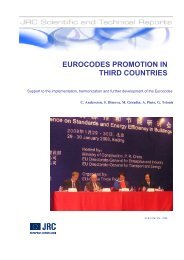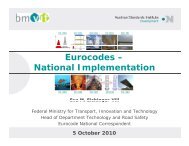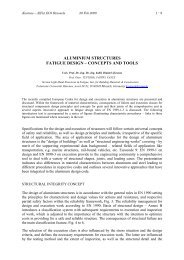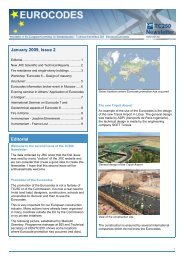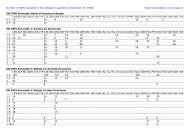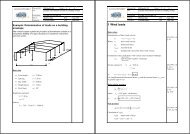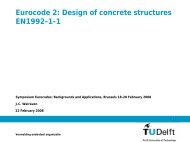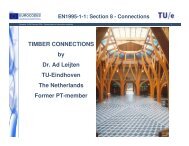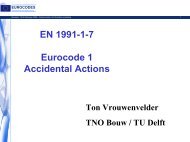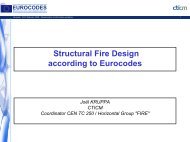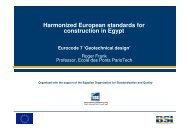GUIDANCE PAPER M CONFORMITY ASSESSMENT ... - Eurocodes
GUIDANCE PAPER M CONFORMITY ASSESSMENT ... - Eurocodes
GUIDANCE PAPER M CONFORMITY ASSESSMENT ... - Eurocodes
Create successful ePaper yourself
Turn your PDF publications into a flip-book with our unique Google optimized e-Paper software.
EUROPEAN COMMISSIONENTERPRISE AND INDUSTRY DIRECTORATE-GENERALChemicals and constructionConstruction4 May 2005<strong>GUIDANCE</strong> <strong>PAPER</strong> M(concerning Council Directive - 89/106/EEC (CPD))<strong>CONFORMITY</strong> <strong>ASSESSMENT</strong>* ) UNDER THE CPD:Initial type-testing and Factory production control(final text April 2005)PrefaceArticle 20 of the Construction Products Directive (89/106/EEC) states thatthe Standing Committee may, "at the request of its Chairman or a MemberState, examine any question posed by the implementation and the practicalapplication of this Directive".In order to ensure as far as possible a common understanding between theCommission and the Member States as well as among the Member Statesthemselves as to how the Directive will operate, the competent services of theCommission, assuming the chair and secretariat of the Standing Committee,may issue a series of Guidance Papers dealing with specific matters relatedto the implementation, practical implementation and application of theDirective.These papers are not legal interpretations of the Directive.They are not judicially binding and they do not modify or amendthe Directive in any way. Where procedures are dealt with, thisdoes not in principle exclude other procedures that may equallysatisfy the Directive.They will be primarily of interest and use to those involved ingiving effect to the Directive, from a legal, technical andadministrative standpoint.They may be further elaborated, amended or withdrawn by thesame procedure leading to their issue.* ) This is the term introduced by the European Commission Guide to the implementationof directives based on the New Approach and the Global Approach (2000), the socalled“Blue Guide”. Other Guidance Papers and many technical specifications(harmonised European standards and European Technical Approvals) use instead theterm “evaluation of conformity”.Commission européenne, B-1049 Bruxelles / Europese Commissie, B-1049 Brussel - Belgium. Office: N105 - 1/57Telephone: (32-2) 299 11 11. direct line (32-2) 299 47 89. Fax: (32-2) 296 10 65. construction@cec.eu.int
<strong>GUIDANCE</strong> <strong>PAPER</strong> M<strong>CONFORMITY</strong> <strong>ASSESSMENT</strong>* ) UNDER THE CPD:Initial type-testing and Factory production control• This Guidance Paper was issued by the Construction Unit of the European Commission,following consultation of the Standing Committee on Construction at the 60 th meeting on26.10.2004, as document CONSTRUCT 04/657, and at the 61 st meeting on 12.04.2005,as document CONSTRUCT 04/657 rev.1.
Acronyms usedAB:AoC:CEN:CEN/TC:Approval Bodies (Bodies authorised by the Members States according toArticle 10 of the CPD to issue European Technical Approvals)Attestation of conformity according to Chapter V and Annex III of the CPDEuropean Committee of Standardisation (Comité Européen de Normalisation)Technical Committee of CENCENELEC: European Committee for Electrotechnical Standardization (Comité Européende Normalisation de l’Electricité)CPD:CUAPCWFTEC:EEA:EOTA:ETA:ETAG:FPC:GNB:GNB-SGhEN:ITT:NB:NPD:Council Directive 89/106/EEC (Construction Products Directive)Common Understanding of Assessment Procedure for European TechnicalApproval without guideline (art. 9.2 of the CPD)Classified Without the need for Further TestingEuropean Commission ServicesEuropean Economic AreaEuropean Organisation for Technical ApprovalsEuropean Technical Approval (CPD Chapter III type of “technicalspecification”)Guideline for European Technical ApprovalFactory Production ControlGroup of Notified BodiesSector Group of Notified Bodiesharmonised European Standard (CPD Chapter II type of “technicalspecification”)Initial Type TestingNotified Body (also called “Conformity Assessment Body” under other NewApproach Directives), which have been designated by Members States for tasksto be carried out for the purpose of conformity assessment). According to theCPD, Notified Bodies include certification bodies, inspection bodies andtesting laboratories,No Performance Determined3
OJEUTCWGOfficial Journal of the European Uniontechnical committeeworking group4
1. Introduction1.1. This Guidance paper addresses the issue of conformity assessment 1 within thecontext of the implementation of Council Directive 89/106/EEC 2 (hereafter referredto as the Construction Products Directive - CPD), as amended. Only aspects relatedto the immediate production of technical specifications are considered.1.2. The Guidance Paper is intended for technical specification writers (CEN/CENELECand EOTA), for consideration together with the respective mandates and provisionsgiven therein. Furthermore, it may as well be of interest, for information purposes, toregulators and enforcement authorities within the European Economic Area (EEA),notified bodies and manufacturers, although the technical specifications, onceavailable will contain all relevant detailed provisions applicable to a given product. Inany case, unless it expressly states otherwise, the Guidance Paper must not be usedfor arrangements not covered by technical specifications. It takes account of theCommunication of the Commission with regard to the interpretative documents ofDirective 89/106/EEC 3 .1.3. Taking into account the experience collected during the elaboration and theimplementation of the first harmonised technical specifications (hENs or ETAs), thisdocument is intended to give the principles and layout which the specification writersstarting to draft clauses on conformity assessment in new harmonised technicalspecifications should follow.1.4. For the existing harmonised standards (hENs) and Guidelines for EuropeanTechnical Approvals (ETAGs) whose reference has been published in the OJEU(part C) and which are already in force, specification writers should modify clausesto conform to the principles shown here when the technical specification comes upfor 5-yearly review, or by earlier amendment. For those currently consideredfinalised but without the reference already published, they should do so withoutdelay before the reference will be published in the OJEU. In both cases, in order notto delay the application of best feasible technical specifications, specification writersshould decide what clauses have priority to be modified.123Other Guidance Papers and many technical specifications (harmonised European standards and EuropeanTechnical Approvals) also use instead the term “evaluation of conformity”.OJ L 40, 11.2.1989OJ C 62, 28.2.19945
Measuring Rate ChangeFully Adjusted Losses(t → t + 1) =Loss(observation(t), portfolio(t+ 1), cost(t + 1)) =(4.1)LP(portfolio(t + 1))Loss(observation(t), portfolio(t), cost(t)) ∗∗ Trend(t, t + 1)LP(portfolio(t))AndFully Adjusted Premium(t → t + 1) =Premium(observation(t), portfolio(t+ 1), rates(t + 1))(4.2a)Multiplying both the numerator and denominator by equal quantities, we derive:Fully Adjusted Premium(t → t + 1) =LP(portfolio(t + 1))Premium(observation(t), portfolio(t), rates(t)) ∗∗LP(portfolio(t))(4.2b)Premium(observation(t), portfolio(tPremium(observation(t), portfolio(t), rates(t))+ 1), rates(t + 1))LP(portfolio(t + 1))∗LP(portfolio(t))Then dividing losses by premium, we derive:Fully Adjusted Losses(t → t + 1)Fully Adjusted Loss Ratio(t → t + 1) =(4.3a)Fully Adjusted Premium(t → t + 1)As stated above, and as implied by equation (4.1), in theory the losses should be adjusted8 Casualty Actuarial Society Forum, Season Year
4.2. For construction products subject to AoC with harmonised technical specifications,the CPD foresees that ITT can be used as a method of control of conformity whendetermining the procedures of attestation of conformity 12 . In practice this meansthat harmonised characteristics for which the manufacturer declares performances(see 4.3) are subject to ITT when the manufacturer first declares conformity with ahEN, even for products already placed on the market. In addition, the need toperform ITT applies to all characteristics included in a technical specification whenthe manufacturer claims conformity, unless the technical specification givesprovisions (e.g. use of previously existing data, CWFT and conventionally acceptedperformance) to declare performances without performing tests.4.3. In order to take into account existing regulations on products where performance(s)for one or more characteristics may not be required, due to the characteristic(s) fora given intended use that is/are not subject to regulation in the Member State(s)where the product is placed on the market, the NPD-option can always be used bymanufacturers (according to the provisions of Guidance Paper E “Levels andclasses” clause 4.11 and Guidance Paper D “CE marking” clause 3.6). In thesecases, the use of phrases "where required" can be confusing and, therefore, shouldbe avoided 13 .4.4. The term ITT is used to cover not only physical testing but also other means ofdemonstrating conformity, such as calculation 14 , conventionally acceptedperformance or tabulated reference data. Even when using CWFT or conventionallyaccepted performances, the manufacturer may need to perform some tests (e.g. ofdensity) to demonstrate that his product meets the definition of the product coveredby such provisions. The need to do this, as well as which test method(s) is/areappropriate, has to be made clear in the technical specification.Test and assessment methods4.5. Specification writers have to ensure that the technical specification for ITT isexplicit on the assessment method, i.e. on how samples are to be taken (either in thetechnical specification itself or by reference to a test or classification technicalspecification containing the information), how many specimens are to be tested,their dimensions and how they are to be mounted in the testing equipment.4.6. Some technical specifications may provide little more than a harmonised list of testmethods and permit manufacturers to declare whatever performance level theproduct achieves from the tests (or other assessments). Other technicalspecifications may set threshold values on some characteristics, or introduce classes(either as a result of the mandate or ‘classes of convenience’). Any combination ofthese three provisions is acceptable, although CEN/TCs and EOTA/WGs have tofollow the provisions of Guidance Paper E when setting levels and/or classes.121314CPD article 13.3.b and Annex IIIInstead, the requirement clauses relating to harmonized characteristics could start with the text: “Thischaracteristic shall be evaluated when subject to regulatory requirements in the Member State where theproduct is intended to be placed on the market. It also may be evaluated, when the product is intended tobe placed on the market in a country without regulation for this characteristic.”For ITT by calculation refer to Guidance Paper K, in particular point 3.4 and its Annex 3.9
CEN/TCs and EOTA/WGs need to ensure that the hEN or ETAG/CUAP is explicitin stating what the compliance criteria are and how the test results are to beexpressed. Technical specifications may require one of the following approaches:– ‘pass/fail’ (in which case it is common, but not necessarily obligatory, toassume that all products tested ‘pass’ 15 ),– test results that are used to establish levels or classes that are declared (e.g. firebehaviour classes),– that the manufacturer states the test result itself, a mean value, or a mean valueplus a declared tolerance, according to what is required by the technicalspecification,– a ‘manufacturer's limiting value’ (the value which all products have to meet orexceed in tests),– other, statistical means of declaration (e.g. characteristic/design value,acceptable or limiting quality levels) 16 .4.7. In some cases, test methods for initial type testing take some time to produce testresults upon which the manufacturer's declaration is based. Without further guidance,this might mean that products cannot be CE marked for being placed on theintended market(s). If this situation is likely to occur, the CEN/TC should considerother verification methods or propose proxy characteristics in their responses to theEC mandates.A further possibility is for a product hEN to foresee a first compliance andverification according to an approach considered sufficient for resulting in aprovisional permission, for a limited time, to place products on the market underdefined and limited conditions, while full verification is undertaken. When thissituation does occur, manufacturers have to initiate ITT well in advance of theirintended placing onto the market of the product (e.g. in research and developmentstep). Depending on the case, applying, where this is possible, article 4 (4) of theCPD, or an ETA, can also be an appropriate solution for such specific cases.4.8. In some cases, a manufacturer might seek ITT results for series production (see4.9.1 and 4.9.2) before he has established a production run and the product(s) is/areproduced in more than just very limited quantities. Where this may happen, becauseit is not possible to perform normal sampling, the technical specification has to givespecific rules related to how products are chosen for ITT, and how these results arethen applied to later production.1516e.g. concerning frost resistance requirements: ”The product shall pass …”(requiring that, for example, 9out of 10 products pass). Furthermore, ‘pass/fail’ requirements do not need to be met if the NPD option ismade use of.Drafters may refer to ISO/TR 13425 “Guide for the selection of statistical methods for standardizationand specification”, or ISO 12491:1997 “Statistical methods for quality control of building materials andcomponents” in order to find an appropriate statistical method, both for ITT and for FPC testing.10
Distinct categories of production4.9. Guidance on ITT taking into account different categories of production4.9.1. Conventional series production:Many products placed on the market are manufactured in large volumes of thesame product made over time. As long as the product remains unchanged,there is no need to repeat the ITT, and neither technical specifications norNotified Bodies need to seek to put ‘lifetime’ limits on ITT reports.4.9.2. Series production of products with varying properties 17 :In this case of products placed on the market, the technical specifications needto give consideration as to how to perform ITT, because although there isseries production, the finished product has potentially different performances(e.g. due to different size). The technical specification shall be specific aboutwhether every product/kit of different size, shape, strength, etc., has to beconsidered as a different product requiring all characteristics, not covered by aproduct range, to be initial type tested, or the technical specification shallcontain provisions to reduce this testing burden (e.g. the concepts of productrange and/or direct or extended application of test results).If, for justified and accepted reasons 18 , the CEN/TC or EOTA/WG is not ableto find an appropriate solution to cover this production categoriesappropriately in the same hEN or ETAG/CUAP, CEN/TC or EOTA/WG maydo so separately or at a later date (through an amendment of the publishedhEN or ETAG). In this case, hENs or ETAGs/CUAPs would have to clearlydefine and exclude from the scope this production category not covered.4.9.3. Individual (and non-series) production (Article 13(5) of the CPD), insofarrequired to be CE marked 19 :(In order to fall into this category, a product must fulfil both criteria,individual and non-series production.)These are products of individual design that are ordered for and installed inone and the same known work. They should neither be part of a range ofequal products, which is manufactured in series of the same kind combiningusual components in the same way 20 , nor should they and their field ofapplication (e.g. dimensions, weight) be offered on the general initiative of the17181920Examples of ‘series’ products with varying properties are steel structures, where each product/kit is of adifferent size, shape and strength, and windows manufactured in a wide range, where many products areof the same design, but of different sizes.In such a case, the CEN/TC or EOTA WG should send to the Commission an amendment to its answer tothe mandate, and the Commission will reply in writing whether this amendment is accepted or not.Article 1 (2) of the CPD defines construction products as those for incorporation in works, and Article 2(1) refers to them being “placed on the market”. Therefore, notwithstanding their responsibilities in thisfield, Member States are not obliged to take measures for applying CPD provisions and CE marking tobuilding elements made on the works and to those construction products that are manufactured off theworks but incorporated in them without beforehand having been placed on the market, i.e. directly by themanufacturer as part of a service comprising more than just manufacturing and delivering the product.often in automatically operating processes11
manufacturer (e.g. by means of published catalogues or other ways ofadvertising).Under these conditions, individual (and non-series) production comprisesproducts that are:– individually designed and manufactured, upon request and for specificpurposes, needing to readjust the production machines for theirmanufacture in order to be used in the work concerned 21 ; or– custom-made for a specific order to obtain one or several end useperformances different from products manufactured in series, even ifproduced according to the same manufacturing process/system design.Note: According to Statement no. 2. for entry into the Minutes of the Councilof 21 December 1988 “The Council and the Commission agree that where aproduct is intended for a single application, Member States may authorisethe use thereof even if it does not comply with the provisions of theDirective” (but without CE marking). In this respect, single-applicationproducts are to be considered being those of individual (and non-series)production falling under the first indent above, and manufactured for onesingle specific case of application that requires one or several individual enduse performances.For individual (and non-series) production, with the exception mentionedhereafter, a declaration of conformity by the manufacturer on the basis of(a) initial type-testing by him that uses conventionally accepted methods oftesting/determining performances, and (b) factory production control, issufficient to attest the conformity with the technical specifications in questionand to allow the product to be CE marked. This must not result in reducedperformance with regard to the requirements laid down in the technicalspecifications. For the purpose of control and surveillance, this declaration ofconformity should indicate the intended use and the work in which theproduct is to be incorporated.In the case that technical specifications are drafted for products which haveparticularly important implications for health and safety, specification writersneed to expressly include a related provision if they consider, for individual(and non-series) production, such a declaration of conformity by themanufacturer (i.e. AoC system 4) as insufficient with regard to theseimplications. If they do so, the technical specifications in question shouldcontain specific provisions regarding ITT of products resulting from individual(and non-series) production for the performance(s) with importantimplications for health and safety that permit these products to be CE markedwithout disproportionate testing (see also 5.12 for FPC aspects).21A product which is manufactured using the same machines the same components and the same process ofmanufacture, but changing only the dimensions can generally not be considered as non-series productand, instead, falls under the category 4.11.2 Series production of products with varying properties.12
Where specification writers consider it possible that technical specificationsconcern a type of product, for which Member States may authorise the use ofsingle-application products that do not comply (see note above) or mayotherwise lawfully regard products not falling under the scope of the directive(see footnote 18 ), they should bear this in mind when drafting the technicalspecifications in question.Reduction of ITT test costs 224.10. Specification writers should consider using in a hEN or ETAG/CUAP the notion of‘product ranges’ which individual manufacturers may define. The product rangemay differ according to the characteristics in question. Although not alwaysessential, using a ‘worst case’ scenario is a good way of defining a product range.4.11. CEN/TCs and EOTA/WGs should also consider introducing, in technicalspecifications, ‘direct’ and ‘extended’ application rules of test results. 23 Such rulesin technical specifications are familiar for fire related characteristics 24 , but they mayalso apply to other performance characteristics. They are more likely to be includedin clauses on testing (or in test technical specifications themselves) than in those onconformity assessment.4.12. Where a manufacturer produces the same product on more than one production lineor unit, or in more than one factory, there may be no need to repeat ITT for thesedifferent production lines or units (the manufacturer takes responsibility for ensuringthat the products are indeed the same).The need to repeat ITT depends on whether the production equipment used in thefactory, and/or the production line or unit, might influence the performancedeclarations forming part of the CE marking. This might be subject to the productor even the production method. Where an influence exists, technical specificationsmay need to specify that ITT needs to be performed for each factory, productionline or unit separately. Otherwise, the individual manufacturer can decide on thisissue, being the ultimate responsible for the declarations accompanying the CEMarking. Manufacturers must be conscious that if ITT is performed on samplesfrom various production units, lines or even factories, they will have to ensure thatthe declarations are valid for all products that rely on that ITT.4.13. To avoid the repetition of testing, also the use of otherwise already existingtransferable test results might be taken into consideration, as presented below.222324As a contribution to further reducing test costs, specification writers should also propose products whichplay a minor part with respect to health and safety for the application of article 4(5) of the CPD.Direct application rules can be considered to be rules which specify how much products/kits may differfrom those tested, while still maintaining the same test result (e.g. “Test results apply to products of thesame composition with a density up to 10% greater than tested”). They effectively define product ranges.Extended application rules (which may contain calculation procedures) predict test results on the basis ofone or more test results for the same test method (e.g. “Where the density differs by more than 10%, butits relationship is not known, a sufficient number of tests is needed to determine the relationship. Oncethe relationship is established, this may be used to calculate the results for products of intermediatedensity values.”) (note that extended application is often used to derive a direct application rule)CEN/TCs and EOTA/WGs should refer to the work ongoing in this area.13
Specification writers are invited to formulate, as an informal part of harmonisedtechnical specifications, further details and guidance to this end, e.g. parameters fordetermining whether products have the same characteristics relevant for a givenperformance and, therefore, can be subject of shared ITT results (see hereafter).4.13.1. Shared ITT results (in principle applicable to all AoC systems)A manufacturer may use ITT results obtained by someone else (e.g. byanother manufacturer, as a common service to manufacturers, or by aproduct developer), hereafter called ‘other party ITT results’, to justify hisown declaration of conformity regarding a product that is manufacturedaccording to the same design (e.g. dimensions) and with raw materials,constituents and manufacturing methods of the same kind, provided that– the results are known to be valid for products with the samecharacteristics relevant for performance;– in addition to any information essential for confirming that the producthas such same characteristics, the other party who has carried out the ITTtesting concerned or has had it carried out, has expressly accepted 25 totransmit to the manufacturer the results and the test report to be used forthe latter’s ITT, as well as information regarding production facilities andthe production control process that can be taken into account for FPC;– the manufacturer using other party ITT results accepts remainingresponsible for the product being in compliance with all the provisions ofthe CPD, including both the design 26 and the manufacture of the product;– he ensures that the product has the same characteristics relevant forperformance as the one that has been subjected to ITT, and that there areno significant differences with regard to production facilities and theproduction control process compared to that used for the product thatwas subjected to ITT; and– he keeps available a copy of the ITT report complying to Guidance PaperK point 6.2 that also contains the information needed for verifying thatthe product is manufactured according to the same design and with rawmaterials, constituents and manufacturing methods of the same kind.Provided that the manufacturer provides the necessary documentation to thisend, and that the notified certification body or notified test laboratory askedto undertake ITT under AoC system 1, 1+ or 3 has verified, by appropriatemeans, that the conditions to do so are fulfilled (see above), the latter mayaccept, upon request by the manufacturer, to use other party ITT results2526The formulation of such an agreement can be done by licence, contract, or any other type of writtenconsent.For certain products (in particular those, for which the performance is calculated using <strong>Eurocodes</strong>) specialprovisions may apply.14
under its responsibility 27 . Under AoC system 1 and 1+, the necessaryverification includes that there are no significant differences with regard toproduction facilities and the production control process compared to thatused for the product that was subjected to ITT 28 .Note: This does not mean “shared ITT”. An ITT concerns the evaluation ofa specific production made by a given manufacturer. In the declaration ofconformity established by the manufacturer, which is a document which canhave legal consequences, the product is identified and the name of themanufacturer is given. Therefore, ITT cannot be shared, but only testresults.4.13.2. Cascading ITT (to be applied under systems 1, 1+ and 3 only 29 )For some construction products, there are companies (system houses) whichsupply or ensure the supply of, on the basis of an agreement 30 , some or all ofthe components (e.g. profiles, gaskets, weather strips for windows) 31 to anassembler who then manufactures the finished product (referred to below asthe “assembler”) in his factory.Provided that the activities for which such a system house is legallyestablished include manufacturing/assembling of products as the assembledone, the system house may take the responsibility for the ITT regarding oneor several mandated characteristics of an end product which is subsequentlymanufactured and/or assembled by other firms in their own factory. Whendoing so, the system house must submit an “assembled product” usingcomponents manufactured by it or by others, to initial type testing and thenmake the ITT report available to the assemblers, i.e. the actual manufacturerof the product placed on the market.Regardless the AoC system under which ITT is the task of a Notified Body(i.e. 1 and 1+ where the notified certification body is responsible forsampling, or 3 where this is a task of the manufacturer) samples for testingthe “assembled product” submitted by the system house need to be taken atthe latter.To take into account such a situation, the concept of cascading ITT might betaken into consideration in the technical specification, provided that thisconcerns characteristics for which either a product certification body or anotified test laboratory intervene, as presented below.2728293031Irrespective of the fact that, under system 3, the manufacturer remains responsible for choosing thesamples.This might need the NB to visit the other party’s facilities in addition to those of the manufacturer.Contrary to sharing ITT results, which is subject to severe formal rules (see 4.13.1) , in order to ensuresufficient traceability and transparency of responsibility, the legally less formalised cascading ITT shouldonly be applied to AoC systems, under which ITT is a task for Notified Bodies.This can be, for instance, a contract, licence or whatever kind of written agreement, which should alsocontain clear provisions with regard to responsibility and liability of the component producer (systemhouse, on the one hand, and the assembler of the finished product, on the other hand.These companies may produce components but they are not required to do so.15
The ITT report that the system house has obtained with regard to testscarried out by a Notified Body, and which is supplied to the assemblers, maybe used for CE marking purposes without the assembler having to involveagain a Notified Body to undertake ITT of the product’s characteristic(s)that were already tested, provided that:– the assembler manufactures a product which uses the samecombination of components (components with the samecharacteristics), and in the same way, as that for which the systemhouse has obtained an ITT report. If this report is based on acombination of components not representing the final product as to beplaced on the market, and/or is not assembled in accordance with thesystem house’s instruction for assembling the components, theassembler needs to subject his finished product to ITT 32 ;– the system house has notified to the manufacturer the instructions formanufacturing/assembling the product and installation guidance;– the assembler (manufacturer) recognises being the one placing theconstruction product on the EEA Market and assumes theresponsibility for the correct assembly of the product in accordancewith the instructions for manufacturing/assembling the product andinstallation guidance notified to him by the system house;– the instructions for manufacturing/assembling the product andinstallation guidance notified to the assembler (manufacturer) by thesystem house are an integral part of the assembler’s FactoryProduction Control system and are referred to in the ITT report 33 ;– the assembler is able to provide, to a Notified Body undertaking ITTof the remaining mandated characteristics or any other task needed forthe attestation of conformity, and for control and surveillancepurposes, documented evidence that the combination of componentshe is using, and his way of manufacturing, correspond to the one forwhich the system house has obtained an ITT report (he needs to keepa copy of the system house’s ITT report);– regardless the possibility of referring, on the basis of the agreementsigned with the system house, to the latter’s responsibility and liabilityunder private law, the assembler remains responsible for the productbeing in compliance with all the provisions of the CPD, including boththe design 34 and the manufacture of the product, which is given whenhe affixes the CE marking on his product. 3532333435in the case of ETA according to the indications by the Approval Bodyor in the system house’s ETA when the product is subject to an ETAFor specific products (e.g. for design using <strong>Eurocodes</strong>) special provisions may apply.However, in case of failure due to incorrect or insufficient installation guidance, authorities must be ableto invoke the liability of the system house or those acting on its behalf. (see also footnote 21)16
4.14. The concept of using “previously existing data” is generally introduced by thesentence “Tests previously performed in accordance with the provisions of thisstandard or ETAG/CUAP (same product, same characteristic(s), same or moretechnically demanding and appropriate test method, sampling procedure and systemof attestation of conformity) may be taken into account.”. Introducing this conceptmay require that the CEN/TC or EOTA/WG determines the limitations of using datafrom previously performed tests. Such limitations may be related to thecharacteristic(s) concerned, the version(s) of the test method(s), the samplingprocedure used, the sample dimensions, etc. The limitations specified in the standardor ETAG/CUAP cannot be related to the status (notified or not) of the laboratorythat performed the test(s) that lead to the previously existing data.4.15. The concept of product range may also apply, where previously existing data applyonly to one or more characteristics of different products within the same range,rather than to the same product.4.16. Where a product or kit manufacturer uses components which have already beenshown (e.g. by CE marking) to comply with one or more requirements of thetechnical specifications applicable for that product or kit, the ITT which led to suchcompliance does not need to be repeated (as long as the component's properties orthe means of determining them remain unchanged). Technical specifications shouldallow for this possibility, but shall also require that the component has the necessaryperformance levels and/or classes to meet the needs of the finished product or kit,taking into account its intended use(s).Permitted alternatives4.17. Use of manufacturer’s testing facilities by notified testing laboratories.4.17.1. In principle, testing laboratories approved for initial type tests for systems 1,1+ and 3 and audit testing (1+) should perform their testing using their owntesting apparatus and personnel.However, such tests may also be performed using the manufacturer’s testingfacilities 36 , i.e. equipment with or without the manufacturer’s testingpersonnel operating it, for testing in the framework of conformityattestation, provided that:– the manufacturer's facilities for testing are calibrated,– the Notified Body agrees to the use of the manufacturer’s testing facilitiesknowing that he retains the responsibility for the test performed and itsresults,– the Notified Body conducts the test, and assists to them also in the casethey are carried out by the manufacturer’s staff,36For instance, if it is excessively complex (e.g. large samples difficult to be transported) or economicallydisproportionate to perform the tests in the Notified Body’s premises.17
– the tests at the manufacturer’s test facilities are performed in strictconformity with the testing procedure of the relevant test technicalspecification, including sampling and the preparation of samples, and– the Notified Body decides whether to take into consideration the testresults or not.4.17.2. Insofar testing laboratories use manufacturer’s testing facilities, it must beassured that they are and must remain third parties independent of theirclients and other interested parties 37 .The use of the manufacturer's testing facilities does not mean any subcontracting(Guidance Paper A clause 3.4). It does not give to themanufacturer the status of a notified body.4.17.3. When facilities of the manufacturer are used by a Notified Body to performall or part of testing this shall be noted in the test report.4.18. Under AoC systems 2+, 2 and 4, for which ITT is a task for the manufacturer, thelatter may entrust this task or parts of it to any party equipped and qualified toundertake correct ITT for the product concerned, provided that all rules relevant forthe AoC system in question will be properly applied.4.19. As far as establishing the fitness for use of products for which the existing technicalspecifications have not been applied, or only in part, attention is drawn to GuidancePaper I “The application of Article 4(4) of the Construction Products Directive”.5. Factory Production Control (FPC)5.1. In the CPD, factory production control means the permanent internal control ofproduction exercised by the manufacturer. FPC is the means by which amanufacturer ensures that the performances declared by him (obtained on the basisof ITT) continue to be valid for all subsequent products. This generally involvesensuring that subsequent products remain substantially the same as those submittedto ITT (i.e. having the same characteristics), although the concept of product rangemay also be applied to FPC. Where the manufacturer involves intermediaries (e.g.his agent established in the EU) for placing the product on the market, this controlmight also need to include the latter’s facilities, i.e. by controlling there thosefeatures of this stage that could affect the product characteristics.5.2. In general FPC is relevant to all characteristics. However, this does not mean that allcharacteristics have to be subject to verification and/or evaluation, or that the samemethods used for ITT have to be used for FPC. FPC may involve control by indirectmeans (for example by control of incoming raw materials and control of theproduction process) or may involve the use of methods different (usually simpler37See Guidance Paper A, point 3.5, in particular 3.5 (b).18
and cheaper) from those used for ITT 38 but for which there is a relationship betweenthe FPC method and the ITT one, at least for the individual product or range ofproducts from each manufacturer. The technical specification should require thatsuch a relationship is established, and indicate how it is established and documented,but the relationship itself does not have to be given in the technical specification.Even when the manufacturer uses CWFT or conventionally accepted performance,and the conformity to these is determined by indirect testing (see note below 3.5),the FPC system may need to require checks that the product continues to conformto the requirements for using such provisions (e.g. if the thermal conductivity is atabulated value based on density, FPC may require that density be controlled).5.3. Where different manufacturers may use different methods of control (e.g. some useprocess control while others use finished product testing), the hEN or ETAG/CUAPneeds to provide for these equally, and may not distort conditions in favour of oneor the other. In addition, technical specifications may not give preferential treatmentto manufacturers operating an EN ISO 9001 quality management system, whether3 rd party certified or not (see 5.4 below on the use of EN ISO 9001). Usually, FPCcombines both, i.e. frequent process control and infrequent finished product testing.In addition, care needs to be taken when drafting clauses on process control, so asnot to directly or indirectly imply or require a specific manufacturing method, as thisis not permitted.5.4. FPC should, in general, be included in the normative part of the technicalspecification, but may be the subject of a separate annex or even a separate technicalspecification. Clauses on FPC for CE marking have to be written taking intoaccount Guidance Paper B, and shall be referred to from Annex ZA. It is notpermissible to make conformity with the whole of EN ISO 9001 (or earlier versionsof the EN ISO 9000 series of standards) normative, but technical specifications mayrequire conformity with those clauses of that standard which correspond to therequirements of Guidance Paper B as part of the overall FPC system. Moreover,manufacturers voluntarily running an EN ISO 9001 compliant quality managementsystem may have a favourable presumption from the Notified Body (under itsresponsibility), provided the terms and conditions of the technical specification arecovered by this EN ISO system.5.5. The specification writers should consider how much detail to give on FPC 39 . Theyshould recognise that the provisions on FPC are binding on both manufacturers andany notified bodies, and that they therefore need to be carefully drafted so as not todistort the market in favour or against a particular manufacturer, manufacturingmethod, quantity of production, type of production control, or any notified body.One way of ensuring this is to write FPC provisions in performance based, ratherthan prescriptive, terms. It is, of course, possible to combine both the performance3839These methods allow the same characteristic or product property to be verified ensuring that theperformances declared by the manufacturer continue to be valid for all subsequent products, but usingequipment and conditions adapted to the means of the manufacturers and the production environment.Regarding FPC related to calculations, see Annex 3 of Guidance Paper K, in particular its items (11),(14), (18) and (22) as far as the tasks of Notified Bodies are concerned.For standards, the ‘minimum’ specification given in the CEN Model Product Standard (document CENBT N888 and Supplement No.2) is no longer considered to be sufficient.19
ased approach and a more prescriptive element, using wording such as “Theperformance requirement is … . A sampling system complying with the frequency oftesting provisions and conformity criteria of Table X is deemed to meet thisperformance requirement.”For technical specifications prepared by EOTA, see 2.2.5.6. Where FPC requires the satisfaction of certain statistical criteria, and these takesome time to be established, the technical specification should indicate how themanufacturer can demonstrate satisfactory FPC before having performed a sufficientnumber of tests to meet longer-term statistical criteria. It should also be borne inmind that the statistical approach is only practicable for those characteristics whichare tested frequently. For characteristics which are tested only infrequently (e.g.once per year) or are not directly tested at all for FPC purposes, alternativerequirements have to be provided.5.7. For products under Attestation of Conformity (AoC) systems 1+, 1, 2+ or 2, if thetechnical specification does not contain sufficient detail, or has already progressedtoo far, to enable all Notified Bodies (CPD art. 18) to work consistently with eachother, the Group of Notified Bodies (GNB) will develop these clauses, which willthen be offered to the CEN/TC or EOTA for subsequent inclusion in the hEN orETAG/CUAP/ETAs, so that they take on a normative status. 40 These clauses will beused by the NBs, until the technical specification is revised. CEN/TC or EOTA/WGshould liaise with the relevant Sector Group of the GNB.5.8. It is permissible to fix, in technical specifications, minimum frequencies for assessing(maybe fixing higher and lower minimum frequencies depending on results), whichmethods to be used, and details of other aspects of FPC, such as defective productsand control of incoming raw materials. The use of frequencies (which generallyshould not be in terms of time, but in terms of quantity of production, e.g. once per1000 m², or in terms of production time, e.g. once per production day) may not,however, be such as to disadvantage manufacturers who invest in moresophisticated methods of FPC control. The use of statistical methods to controlproduction (e.g. control charts) 41 may be more appropriate for certaincharacteristics. All these are technical items for the CEN/TCs or EOTA/WGs toinclude, if they decide to do so, in the harmonised standard or the ETAG/CUAP andthe Control Plan which is part of the confidential files the ETA is referring to.5.9. In application of the CPD Annex III, Attestation of Conformity systems 1+, 1 and2+ include “Further testing of products in accordance with a prescribed test plan”.This is generally assumed to cover FPC testing of finished products 42 . The CEN/TCor EOTA/WG should liaise with the GNB to establish what is necessary to satisfythis requirement, which may then be presented either as a sub-clause in its own404142For harmonised standards for which attestation systems 3 and 4 apply, i.e. where FPC is not subject to anythird party evaluation, specification writers cannot rely on the GNB for support to include sufficientdetail.Information on control charts can be found in ISO 7870:1993 “control charts – General guide andinstruction”, ISO 7966:1993 “Acceptance control chart” and ISO 8258:1991 “Shewhart control chart”Regarding FPC related to calculations, see Annex 3 of Guidance Paper K.20
ight, or be included as part of normal FPC testing of finished products. However,where the nature of the product or the method applied is such that no testing of thefinished product is performed, this requirement may be excluded (and Table(s) ZA.3in Annex ZA of harmonised standards, or similar information in an ETAG/CUAP,would be correspondingly adapted).5.10. Where a manufacturer operates different production lines or units in the samefactory, or production lines or units in different factories, and these are covered by asingle, overall FPC system, the manufacturer still has to keep control records foreach separate production line or unit (and this shall be made a requirement of thetechnical specification). However, when performing FPC inspections, although theproduct specific aspects need always to be evaluated, the Notified Body does nothave to repeat systematically the assessment of ‘general’ FPC provisions whichapply to all lines/units.5.11. In some cases, a manufacturer may seek CE marking for an innovative or similarproduct 43 , for which he does not yet have a fully operational FPC system. For suchcases, the technical specification should specify the requirements that apply beforethe FPC system is fully operational, in order to allow the manufacturer to claimconformity to the technical specification, and what requirements apply once thesystem is fully operational.5.12. In the case of single-application products (see 4.11.3), some of the aspects of FPCused for series production (e.g. finished product sampling) do not apply. Themanufacturer will, however, still have to have an FPC system, for examplecontrolling raw materials and keeping records. Where products covered by a hEN orETA may be produced as single-application, the FPC clauses need to be written in away which gives exemptions from those requirements which apply to seriesproduction only; however, the specification writers should be aware that therequirements for all products covered by one harmonised technical specificationhave to be equivalent.5.13. In the case of kits, a number of different options may exist.5.13.1. The kit manufacturer manufactures all components, in which case he takesfull responsibility for the FPC regarding the kit, including its components(which may, where required by the technical specifications for the kit, gobeyond the requirements laid down in the specification for that component asa single product, even if CE marked).5.13.2. The kit manufacturer puts a kit on the market, for which he manufacturessome components only and buys in other components 44 . In this case, the kitmanufacturer is responsible for the FPC of the kit as a whole, including thecomponents which he manufactures (see 5.13.1 above), also as far as4344Usually, such products are outside the scope of hENs and, to be CE marked, require technicalspecifications in the form of an ETA. When production and FPC are not (fully) running, the demonstrationof the conformity of the product shall be mainly done operating control/tests on the final product (finalcontrol/test).to be considered “incoming materials/products”21
equired by any other technical specification applicable to these components.Furthermore, regarding the component(s) that he buys in, he is responsible,where required by the technical specifications for the kit, for defining anynecessary FPC requirement beyond those applicable to them as a singleconstruction product. The following principles apply to the bought incomponents:– The kit manufacturer enters into a contract with the componentmanufacturer, obliging the latter to perform FPC in accordance with theprovisions of the technical specification applicable to the kit, to besubjected to third party assessment according to the rules to be applied ifrequired so by the AoC system applicable, and to submit the required FPCrecords to the kit manufacturer.– The kit manufacturer purchases one or several components on the openmarket (CE marked or not) or from a component manufacturer. In thiscase, the kit manufacturer has to take full responsibility for demonstratingthe conformity of the kit as a whole, and all its components, with thetechnical specification, and, therefore, needs to operate a FPC systemensuring that conformity is maintained, in total. However, since the kitmanufacturer, in this case, does not manufacture all kit components, theFPC cannot be entirely based on process control in his premises, so thatnormally it has to be based on finished product testing. Where thisapplies, the technical specification will need to include this possibility, andmay be different from the FPC requirements for kit manufacturers thatmanufacture all components themselves 45 .5.13.3. The kit manufacturer uses only bought in components, in which case he isresponsible for the FPC of the kit as a whole, and the principles of 5.13.2apply accordingly for the bought in components.Note: The guidance regarding kit components applies only to components that playa key role in the performance of the kit as defined in the technical specificationsapplicable. Technical specifications of the kit should identify which componentsplay such a key role and specify applicable FPC requirements. For those playing aminor role, FPC based on identifying that they comply with the specification givenby the manufacturer of the kit will be adequate.5.14. It can be that the manufacturer of a single construction product or a kit, hereaftercalled “the basic product”, expressly prescribes or requires a specific additionalproduct to be applied for the intended end use (e.g. for fixing or site appliedfinishing), which plays a key role in the end use performance of the basic product asdefined in the technical specifications applicable, but is not part of the basic product,although it constitutes with the latter a “virtual kit”, and whose manufacturer doesnot need to operate a FPC system complying with the provisions of the technicalspecification for the basic product.45ISO 3951 and ISO 2859, which define receiving inspection, may form part of such a control process specified in thestandard.22
In this case, the manufacturer of the basic product should, where relevant, identifyany necessary FPC requirement beyond those applicable to this key additionalproduct as a single construction product and ensure himself that this is observed.Furthermore, he may be required to include in his FPC the indications needed toverify whether any potential change in the characteristics of this key additionalproduct risks to reduce the end use performance of the basic product concerned.Where AoC system 1, 1+ or 2+ apply, the specifications for the basic productconcerned may include provision to have this appropriately verified under thecontinuous surveillance of the manufacturer’s FPC undertaken by a Notified Body.Note: Technical specifications of the basic product should identify whichadditional product(s) play(s) such a key role and specify applicable FPCrequirements.5.15. When drafting FPC clauses, it may be useful to separate them into 'FPCrequirements for all manufacturers' (e.g. frequency of FPC testing) and'Manufacturer-specific FPC system requirements' (e.g. personnel and equipment).Because these latter are manufacturer-specific, it may not be appropriate for the textof the EN to define their details 46 .6. Additional remarksAs far as the responsibilities of a manufacturer, Notified Body and any other body actingin the attestation of conformity systems need to be clarified, information can be found inthe Guide to the implementation of directives based on the New Approach and theGlobal Approach, available from the European Commission.Because of issues such as batch sizes related to sampling (e.g. batches become smaller asthey pass through the supply chain), specification writers may add, as an informal part ofharmonised technical specifications, an additional clause dealing separately withsampling, testing and compliance criteria beyond those relevant for conformityassessment 47 .-----------------------------------4647For products subject to ETAs, the details are given in the control plan which is part of the confidentialfiles attached to the ETA., on the basis of the corner stones provided in the ETAG-CUAPSuch clauses could also be helpful for other purposes, including those to which technical specifications donot apply, for instance for market surveillance by public authorities. It may be, for example, that thenumber of tests needed for market surveillance is significantly smaller than those required for initial typetesting and FPC purposes.23



